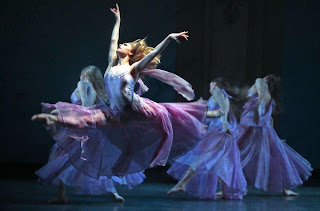
If I had to describe the newly revised Off-Broadway revival of Carrie in one word I’d call it sweet, but not in a condescending way. That’s an odd word for a musical based on a horror novel by Stephen King that ends in so much violence and death, but this MCC Theater production at the Lucille Lortel Theatre has a simple, old-fashioned feel to it that had my friend Maureen and me hooked right from the start.
We had not expected to like it. After all, the original 1988 Broadway production, which I didn’t see, was a laughing stock and one of the biggest flops in musical theatre history. It cost $7 million to mount and ran for only 16 previews and five performances. But here director Stafford Arima handles the story (book by Lawrence D. Cohen) of teen bullying and dramatic revenge with just the right touch of sympathy and gore, toning down the original excesses. It’s a quick, involving two hours.
All of the elements worked for me, but the three standouts are Arima’s creative direction, Molly Ranson’s magnetic performance as Carrie White and Kevin Adams’ transformative lighting.
Everything about Ranson’s performance paints of portrait of Carrie’s past as the only child of a mentally ill, fundamentalist Christian single mother (excellently played by Broadway veteran Marin Mazzie, left in photo). She wears a drab ankle-length full skirt and long-sleeved sweater (costumes by Emily Rebnolz), with her hair in a bun and no make-up. Her posture conveys her shyness and fear as she seems absolutely recoiled into herself. I wanted to go onstage and hug her.
David Zinn’s minimalistic set -- only a few straight chairs and tables -- are transformed into the Whites’ house and school gym thanks to Adams’ highly effective lighting, which, with Matt Williams’ choreography and Mary-Mitchell Campbell’s musical direction and arrangements, powerfully create the cataclysmic revenge scene with little in terms of props and much in terms of drama. I was riveted.
Maybe I should stop here to recap the story for anyone who hasn’t read the book (I haven’t) or didn’t see the wildly popular 1976 film starring Sissy Spacek. (I saw it on video years later.) Carrie’s father has abandoned the family long ago and she lives with her unstable mother, who has brought her up with extreme ideas of sin and little knowledge of reality.
One day after gym class Carrie gets her period for the first time -- at 17 -- in the shower and runs out to the other girls, terrified that she is dying. For years they have called her Scary Carrie behind her back, but have otherwise not paid much attention to her. This incident is too much for them, though, and they laugh at her and pummel her with sanitary products.
Seeing how terrified and uninformed Carrie is, one of the students, Sue Snell (nicely played by Christy Altomare), regrets her unkindness and sets forth from then on to make amends. But Chris Hargensen (played with relish by Jeanna De Waal), the meanest of the mean girls, plans a public humiliation for Carrie that will make the shower incident seem mild.
Carrie, however, is no longer defenseless. The trauma of the shower episode unleashed something in her of which she had been unaware -- her telekinetic gift, the ability to move objects though the power of her mind. The Act One closer is a delightful turn when Carrie puts her mother in her place. She will do the same later with her classmates, with much more deadly results.
A word of caution if you saw the movie. Undoubtedly you have never forgotten that final scene because you -- and everyone around you including the guys -- screamed in fright. That scene isn’t in the play. I know I wasn’t the only one expecting it because a woman near me said: “Is that the end?” when the lights dimmed. I was waiting for it and wish they had used it, although it would have been hard to stage.
Other than that, I thoroughly enjoyed the entire production. All of the members of the cast are good, but then this musical has a history of attracting strong actors. Barbara Cook played the mother in the London premiere and Betty Buckley took over the role when the show opened on Broadway. Piper Laurie played Mrs. White in the film.
The songs (Michael Gore’s music and Dean Pitchford’s lyrics) served more to move the plot along than stand out on their own. I liked that. It made for a nice, tight piece of theatre. Maureen was shocked when we came out to learn that two hours had gone by.
Unfortunately a show about bullying is as timely today as ever. But Carrie’s run is not timeless; it will end April 8, two weeks prior its previously announced extension. If you can’t make it to the theatre, though, you may have another chance to see the show.
"MCC, the authors, and the director achieved what we all set out to do – to rescue Carrie from oblivion and to give her new life,” MCC artistic directors Robert LuPone, Bernard Telsey and William Cantler said in a press statement. “Plans are underway to preserve this production for Lincoln Center Library for the Performing Arts, so it may live on in the memories of the thousands of theatergoers who saw and loved it."
A $20 rush ticket is available for theatregoers under 30. Arrive two hours before the performance with valid identification. Visit mcctheater.org for more information.












